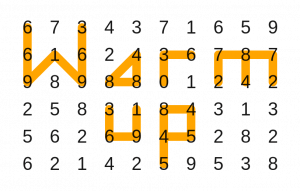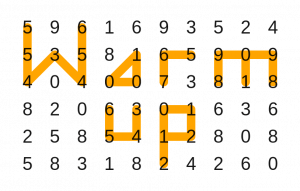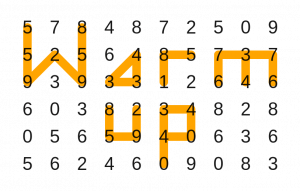Begriddled warm-up puzzles
NB I’M WORKING ON THIS PAGE RIGHT NOW. Yes, I know it isn’t the done thing to makes something available so prematurely. But as you’re here, maybe you’ll find it helpful even in it’s state of unreadiness.
The best way to learn how begriddled puzzles work is by doing a simple example.
Click or tap adjacent pairs of numbers in the grid below to draw or erase lines between them.
Join every horizontal and vertical pair of numbers that are the same.
Also join numbers that are one apart, vertically, horizontally, or diagonally. So 0 to 1, 1 to 2, 2 to 3, and so on, and also 9 to 0.
Or, if you can’t be bothered with all that, you can simply view the ridiculously simple rules here.
If you’ve found all the joins, and haven’t joined anything that’s not meant to be joined, you should be able to read the result. The ‘a’ might look a little strange at first, but after you’ve seen it a few times it will just look normal.
- Like all vertical pairs of the same number, the two 5’s at the top left join together.
- Like all horizontal pairs of the same number, the pair of 0’s in the third row join together.
- Like all diagonal pairs of the same number, the pair of 5’s at the bottom left DO NOT join together.
- The 4 at the left of the third row joins to the 5 above and the 3 diagonally up to the right, because it is one less than the 5 and one more than the 4, and numbers that are one different join diagonally as well as horizontally and vertically.
- The 0 near the end of the second row joins to the 9’s either side of it, because 9 joins to 0, and also the one below.
- The pair of 0’s towards the middle of the third row join to each other and the one above to form a triangle.
- There are quite a few numbers that don’t join to anything at all, especially at the bottom left and right, and most of the first row.
Finally, view the solution below.
In that first example the sequence of numbers was 0 – 2 – 3 – 4 – 5 – 6 – 7 – 8 – 9 – 0.
But the numbers can be in any sequence.
Here’s the exact same puzzle but using a different sequence: 3 – 4 – 0 – 2 – 9 – 5 – 8 – 1 – 6 – 7 – 3
So you join pairs of the same numbers exactly as before, but this time instead of joing 0 to 1, 1 to 2, etc, you now join 3 to 4, 4 to 0, 0 to 2, and so on for the whole sequence.
Try it, and you will see that it really is identical.
Notice how no set of joined up numbers is more than three numbers high: The set of joined up numbers forming the W and p are both three numbers high. The rest are two numbers tall.
Similarly no set of joined up numbers is more than three numbers wide: Only the sets forming the W and m are three wide. The rest are two wide.
With begriddled logic puzzles you don’t get told the whole sequence. You have to work out the unknown numbers, which might be as many as all ten of them, using an additional rule, such as no set of joined numbers being more than three numbers wide or high.
Here is the exact same puzzle yet again, this time with yet another sequence, but with three numbers in that sequence not given, but instead replaced by question marks.
The sequence is 0 – 3 – 6 – ? – ? – ? – 4 – 8 – 7 – 2 – 0
Can you work out the missing numbers to complete the sequence, knowing that the maximum width and height of any set of joined up numbers is 3 numbers, and without using the fact that you already know what the solution looks like?
Try it, and then view the solution to see one way of working it out. If you succeeded, did you do it the same way as me?

Here is one way to solve this puzzle.
Given the sequence above, the only pairs of numbers you cannot join immediately are the three missing ones (1, 5, and 9) joining to anything.
But you know, from the sequence, that these three numbers come together: 1-5-9, 1-9-5, 5-1-9, or the reverse of any of these.
Look at the bottom row of numbers. It includes the numbers 5 9 5 together in a row.
Diagonally up to the left from the left hand 5 is a 9.
So if 5 were to join to 9, you would have a set of joined numbers four numbers wide. But the maximum width is three numbers. So 5 cannot join to 9.
Looking at the possibilities above, the only way for 5 not to join to 9 is for 1 to be in the middle.
That means that 4 must join either to 5 or 9.
If you have joined all the numbers that you can, from the sequence, you will see an 8 joining to two 4’s in the bottom half of the puzzle.
To the left of the left hand 4 is a 9, and diagonally down to the left from that 9 is another 4.
So if 4 were to join to 9, that would result in a set of joined numbers four numbers wide, which can
not be.
So 4 must join to 5, and the only possible sequence, using the given sequence, that does not result in a set of joined numbers being more than three numbers wide or high is: 0 – 3 – 6 – 9 – 1 – 5 – 4 – 8 – 7 – 2 – 0.
Having worked out the sequence, you can now draw in the lines.


